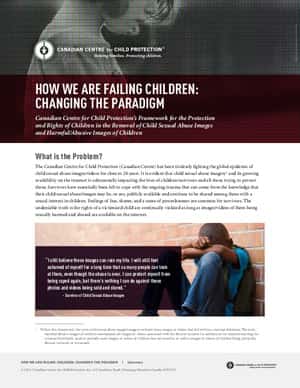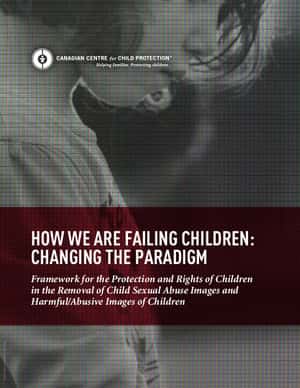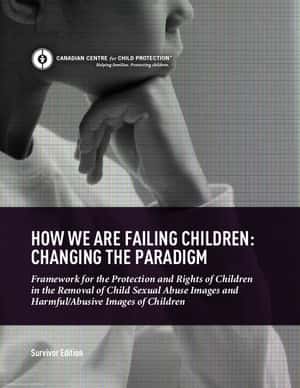We want to remind industry that these are real children in these photos that they receive notices for. We want people to stop thinking of this as a victimless crime and separate child abuse imagery from pornography. Pornography is consensual between two adults. [Child sexual abuse material] is never a choice for that child; it is abuse and we never agreed to have it shared.
How we are Failing Children: Changing the Paradigm
How We Are Failing Children: Changing the Paradigm is an urgent call to action for governments, industry, and hotlines around the world. Current policies for the removal of child sexual abuse images have been focused on determining and removing material deemed illegal under criminal law. In contrast, this framework is grounded in the best interests of the child, and their right to dignity, privacy, and protection from harm. The undeniable truth is the rights of a victimized child will be continually violated as long as images of them being sexually harmed and abused are available on the internet.
Scope of the Problem
- Since it launched in 2017, C3P’s Project Arachnid has detected 20+ million suspected images of child sexual abuse for analyst review, and issued more than five million removal notices to industry.1
- The National Center for Missing and Exploited Children’s (NCMEC’s) CyberTipline, the largest hotline of its kind in the world, averages approximately one million reports of child sexual exploitation each month and has received, in total, more than 45 million2 reports.
- 87% of participants in C3P’s International Survivors’ Survey3 noted they were 11 years old or younger when hands-on abuse began, and for 56% of the survivors, the abuse began before the age of four.
- Deeply concerning was the duration of the abuse, which for 36% of the survivors, continued into adulthood.
- Nearly 70% of respondents indicated they constantly worry about being recognized by someone who has seen images/videos of their abuse, and 30 respondents reported being identified by someone who has seen images/videos of their abuse.
Issues with Current Responses
While there are many ways in which this epidemic is not being addressed appropriately, the framework has identified several key areas of concern:
- A rigid adherence to narrow criminal law definitions. Criminal definitions do not account for the wide range of harmful/abusive images that are available, and are too restrictive when making decisions about image removal. This means a significant proportion of harmful/abusive images remain online.
- The varying levels of commitment to safeguarding children demonstrated by technology companies (e.g., some are swift to remove material once they are notified, and others enter into debates or ignore notices all together).
- Failure to remove all images in an abusive series. Numerous images are created in connection with an abusive series, some of which do not (in isolation) technically meet a criminal law threshold, but are still a part of the continuum of abuse experienced by the child. For example, a series may start with an image of a child being clothed and then the images progress to the child being sexually abused. The clothed image is still a memorialization of the child’s abuse.
- Inconsistent and subjective assessment processes by industry. For some industry members any signs of physical maturity will result in an image not being removed in spite of having received the removal request from a trusted/verified hotline.
- Physical abuse images/videos are often not addressed. The physical abuse is extreme and sometimes includes elements of bondage or even physical torture.
- Arbitrary application of terms of service by industry. Companies interpret and apply these rules without any real avenues for review or appeal by members of the public. Operating independent of any meaningful oversight has inevitably resulted in arbitrary decisions associated with image removal.
Framework for Action
C3P is proposing a set of principles for action that prioritizes the protection and rights of children in the removal of child sexual abuse images and harmful/abusive images:
-
Expand removal to include all harmful and abusive images of children, including:
- All images associated with the abusive incident. These images often do not meet criminal law definitions but are still part of the continuum of abuse.
- Nude or partially nude images of children that have been made publicly available (typically stolen from unsecured social media accounts or secretly taken images), AND are used in a sexualized context or connected to sexual commentary.
- Images/videos of children being physically abused, tortured, or restrained.
- Industry must act on removal notices without subjectivity or unevenness when notified by a trusted/verified hotline, which includes internet providers denying services to those negligent or complicit in the online availability of child sexual abuse images.
- Government must take leadership and provide laws that put the interest of children at the center of this discussion.
- Society must demand change.
Quite simply it is no longer an option to accept the status quo. We know too much about the ways in which children are being exploited and victimized. This framework is an urgent call to adopt criteria for removing images/videos that focuses on what is in the best interest of the victimized child.
Read the Framework
Learn more about how C3P is using technology to combat this global epidemic through Project Arachnid.
Message to the Survivors of Child Sexual Abuse
We acknowledge that the information in this document may be difficult to read. As you go through the report, allow yourself space to be aware of any strong emotions it stirs up in you. If the feelings get to be too much, take a break, reach out to supports in your circle, or do whatever else you might need to become centered again. It’s important to pace yourself and to give yourself all the time you need.
A note about language and terms used in this document: Some people don’t like to define their past and/or present experiences by labels and/or the label they give it may change over time. In this document we chose to use the term “survivor,” but there is a wide spectrum of language that can range from “victim” to “thriver” and even “warrior.” Whatever word you choose (or if you choose no word at all), know that we understand human beings cannot be reduced to any single experience. We acknowledge this by standing with you and supporting you wherever you are in your journey.
If you wish, you may share any thoughts you have on the framework or your own personal experience by contacting us at support@protectchildren.ca. You may also contribute information about your experience by completing our International Survivors’ Survey.
- 1 As of July 2020. ↩
- 2 As of April 2019. ↩
- 3 View the full results of the Canadian Centre for Child Protection’s International Survivors’ Survey at protectchildren.ca/surveyresults. ↩


